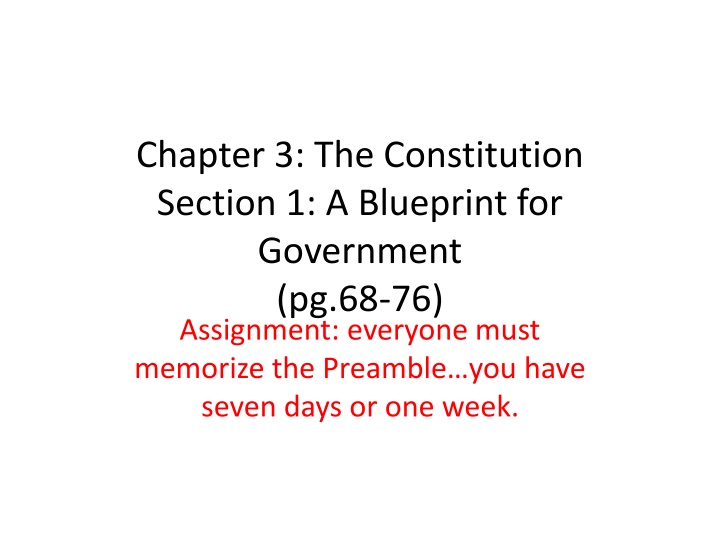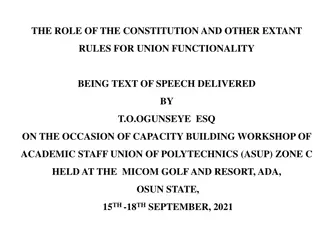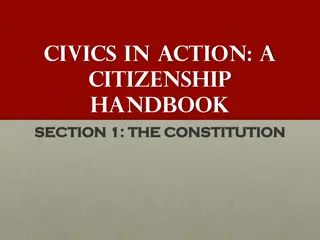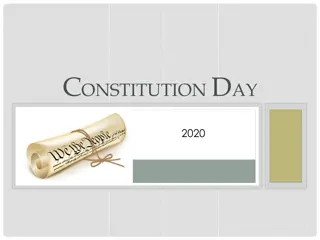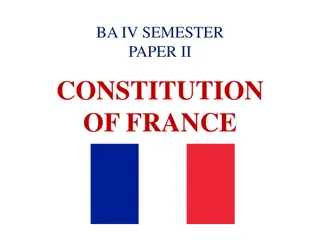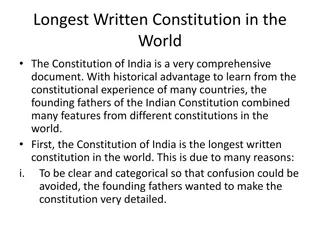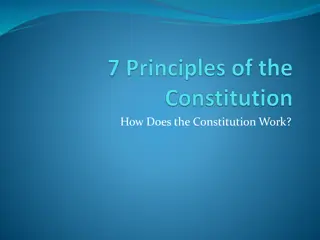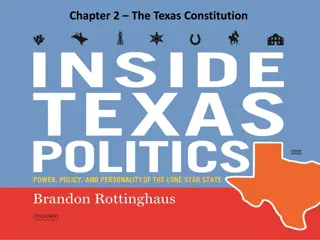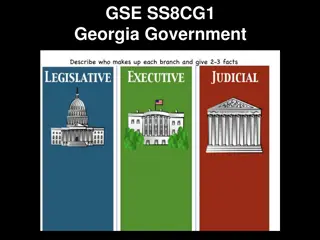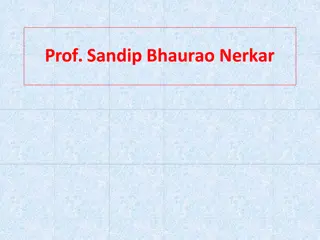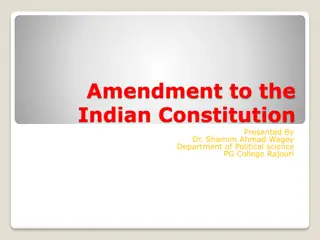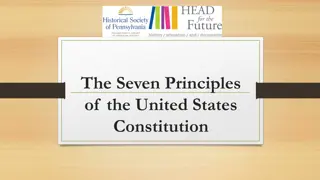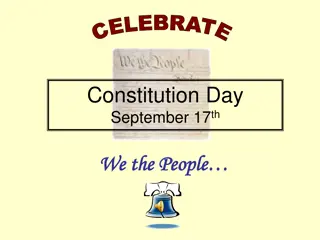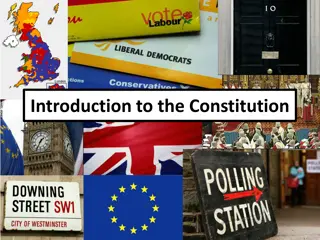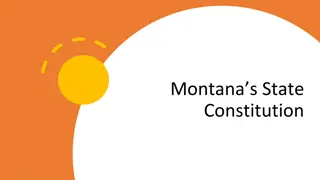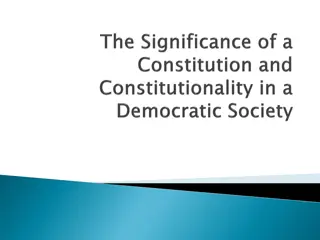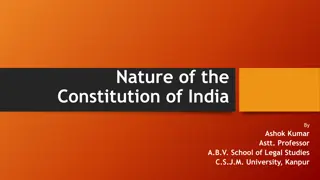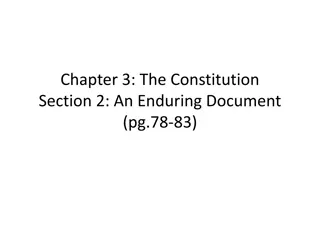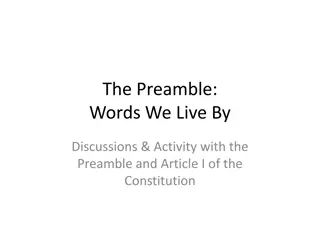The Blueprint for Government: Goals and Principles of the Constitution
The content delves into the foundation of the U.S. Constitution, highlighting the goals and principles behind its creation. It discusses the Framers' intent to prevent government tyranny, drawing inspiration from historical civilizations and philosophers. Exploring the Preamble, it outlines the six key goals of the Constitution, emphasizing the importance of unity, justice, peace, defense, welfare, and liberty. The narrative highlights the insights of influential figures like James Madison and John Locke in shaping the government's structure and powers.
Download Presentation

Please find below an Image/Link to download the presentation.
The content on the website is provided AS IS for your information and personal use only. It may not be sold, licensed, or shared on other websites without obtaining consent from the author.If you encounter any issues during the download, it is possible that the publisher has removed the file from their server.
You are allowed to download the files provided on this website for personal or commercial use, subject to the condition that they are used lawfully. All files are the property of their respective owners.
The content on the website is provided AS IS for your information and personal use only. It may not be sold, licensed, or shared on other websites without obtaining consent from the author.
E N D
Presentation Transcript
Chapter 3: The Constitution Section 1: A Blueprint for Government (pg.68-76) Assignment: everyone must memorize the Preamble you have seven days or one week.
Governing After the Revolution The Framers of the Constitution wanted to keep government from suppressing liberty They had studied the Greek city-states and the Roman Empire, along with the current European states In 1787, they were determined not to repeat the mistakes of the past. https://upload.wikimedia.org/wikipedia/commons/9/9d/Scene_at_the_Signing_of_the_Constitution_of_the_United_States.jpg
Addressing the Problem of Governing As James Madison wrote if we were angels we would not need a government. The Framers drew from John Locke who wrote where there is no Law, there is no Freedom. Therefore, Government must be allowed enough power to be effective, and compelled to exercise restraint. http://www.usnews.com/dims4/USNEWS/cd5da1b/2147483647/resize/652x%3E/quality/85/?url=%2Fcmsmedia%2F62%2F7fff804cd2dd206bb17ef25bddddbc%2F43918WideModern_JamesMadison_070213.jpg James Madison: Father of the Constitution
Six Goals of the Constitution These goals were stated in the Preamble. The 1st was to form a more perfect union The purpose of this goal was to strengthen the relationship among the states as part of a union and between the states and the national government as part of a new federal system http://onlinesocialstudies.mpls.k12.mn.us/uploads/l0768214238.jpg
More Goals of the Constitution 2ndEstablish Justice Provide laws that are reasonable, fair, and impartial and make sure that the administration of those laws is also reasonable, fair, and impartial 3rdEnsure Domestic Tranquility Keep peace and maintain order within the country 4thProvide for the Common Defense Defend the nation against foreign enemies 5thPromote the General Welfare Allow all states and citizens to benefit militarily and economically from the protection of a strong national government 6thSecure the Blessings of Liberty Protect the liberties recently won in the American Revolution and preserve them for the generations to come
The Constitution is a Blueprint Without the amendments the constitution is just over 4,500 words. The Constitution has three parts: the Preamble, the seven articles, and the 27 amendments There are six principles of the Constitution http://www.clker.com/cliparts/5/8/e/e/1333837644869972671constitution.jpg Oldest written Constitution still in use
The Six Principles of Government in the Constitution 1st Popular Sovereignty the people establish government and are the source of its power. In- other-words we are a republic and we elect our representatives. However, the Framers had no intention of putting unlimited power in the hands of the majority. Examples: the election of the President, the Senate, & amending the Constitution http://dnastrandloewe.weebly.com/uploads/1/3/7/9/13790029/1348508602.png http://dnastrandswright.weebly.com/uploads/1/3/7/9/13790000/818100394.jpg?253 http://dnastrandswright.weebly.com/uploads/1/3/7/9/13790000/610568588.jpg
The 2nd Principle of Government in the Constitution 2nd Limited Government Government powers are restricted to protect individual rights This principle is also known as the rule of law, the concept that every member of society, including the ruler or government, must obey the law and is never above it. https://upload.wikimedia.org/wikipedia/commons/c/ce/President_Andrew_Johnson.jpg http://www.archives.gov/presidential-libraries/events/centennials/nixon/images/rn-2-m.jpg https://upload.wikimedia.org/wikipedia/commons/4/49/44_Bill_Clinton_3x4.jpg
3rd Principle of Government in the Constitution 3rd Separation of Powers The power to govern is divided among executive, legislative, and judicial branches to prevent the concentration and abuse of power by any one branch. See page 72 http://frenchrevolutionarmstrong.weebly.com/uploads/1/3/7/5/13759343/1348521430.jpg
4th Principle of Government in the Constitution http://caucasuselections.files.wordpress.com/2012/06/checks-and-balances.jpg 4th Checks and Balances Each branch of government has the authority to check, or restrain, some powers of the other two branches. Congress Controls taxes or money President has the veto Supreme Court can rule acts unconstitutional
5th Principle of Government in the Constitution http://s3.amazonaws.com/edcanvas-uploads/27893/local/1361064501-judicialreview.jpg 5th Judicial Review the judiciary has the power to strike down laws and other government actions as invalid under the constitution, this mean the law or act is than unconstitutional The 1st time this was done was in 1803, in the case Marbury v. Madison
6th Principle of Government in the Constitution 6th Federalism The rights of the states are protected by dividing powers between the nation government and the state government. Article I Section 8, gives Congress the power to make all Laws necessary and proper for carrying into Execution the foregoing Powers. Article VI contains the supremacy clause which makes the Constitution the supreme law of the land. http://3.bp.blogspot.com/_41r4-VqK2SE/TAR277L9CRI/AAAAAAAAAak/PxQWPB0NG-I/s1600/Federalism_020.jpg
